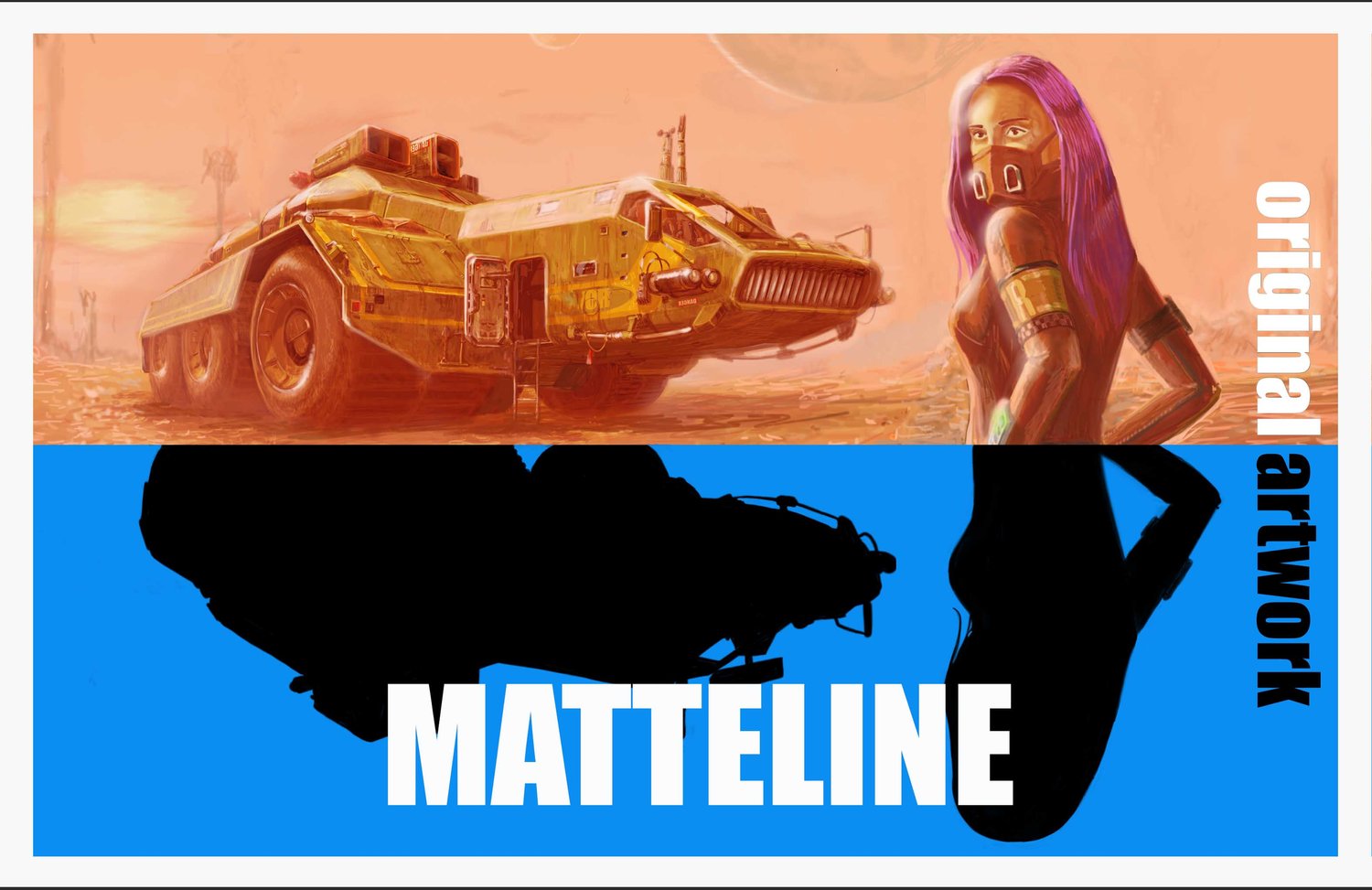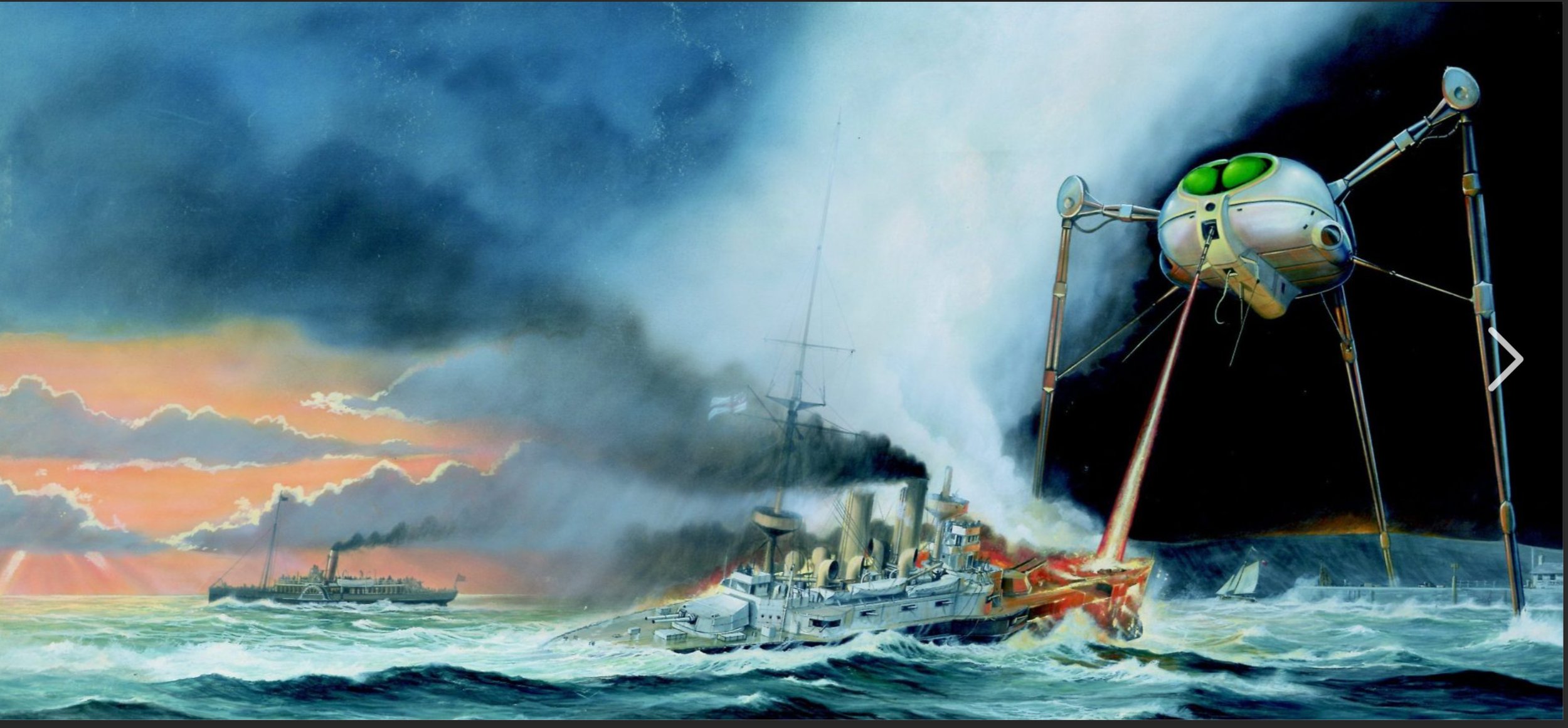The War of the Worlds
November 2023
I can’t recall a time in my life when I was not aware of this classic Sci-Fi story. My introduction was seeing the 1953 film on TV. Produced by George Pal, directed by Byron Haskin and starring Gene Barry and Ann Robinson. The film is a classic in its own right, and is a loose adaptation of the HG Wells novel.
Martian War Machines from the George Pal film. Visual Effects supervised by Gordon Jennings (1953)
‘The War of the Worlds’ was first published in magazines in 1897, and the book was released a year later in 1898. 125 years ago! The story of a race with superior technology, teetering on the edge of extinction and invading the Earth as a means of colonising our world for their own purposes is as timely today as it has ever been. The book is told in the first person and the narrator meets several people who speculate on the Martian civilization and their technology. Little is ever determined for sure. The Martians are mysterious. Their technology is beyond anything that the common man has ever encountered. Most of the action that deals with the ‘Martians’ is actually involving the machines. Much like the Daleks of Doctor Who who are actually controlled by a creature hidden inside, we think of the exterior ‘pepper pot’ machine as a Dalek.
Dalek – created by Terry Nation for Doctor Who. Designed by Raymond Cusick (1963)
The Martian invaders are discussed referencing the giant mechanical tripods, and not the creatures themselves. The faceless enemy is a powerful aspect to the story. There is nothing to reason with or communicate with.
There is some dialogue in the 1953 film that speculates on whether the Martians are using a certain type of electro-magnetism or something for their needs and a reporter asks the character played by Gene Barry – a top level scientist - if it is possible, to which he replies, simply, ‘if they do it, it is’. This moment speaks volumes. As he has been established as a highly respected scientist, a top man, and he basically shrugs at what the Martian machines can do as they are so much more technologically advanced than us.
The Martian machines featured in the novel were described in detail and featured illustrations in the first edition by Warwick Goble. Towering tripods with flexible mechanical tentacles and a metallic dish-like head, or hood with a Martian creature inside. The images are very dramatic and are both detailed and impressionistic at the same time. Like the book itself. They evoke the sense of chaos the invasion has wrought.
Original illustration from ’The War of the Worlds’ Warwick Goble (1898)
Orson Welles, and his influential and successful Mercury Theatre company produced a radio play version in 1938.
Newspaper Headlines after the Orson Welles’ radio broadcast (1938)
This version brought the story into present day America and was written as a sort of series of news reports that interrupt regularly scheduled light entertainment programs. This maintains the feeling that you-are-there in a similar way to the way the book does with its first person narrator observing the events. We hear live on the scene reporters who are cut off while reporting on these strange machines from another world. The regular programming was all fake and part of Welles’ show. It is very authentic. It was broadcast on October 30th, the day before Hallowe’en, and although here are several disclaimers during the show many people tuning in thought it was all really happening and fled their homes. Recordings of this broadcast are available and it is chilling to listen to even today.
In 1975 there was a TV movie about the Welles broadcast called ‘The Night that Panicked America’ which aired on October 31st and did a convincing job of illustrating the events of that night in 1938. I recall a scene of a group of men with shotguns start shooting at a metal water tower, the criss-cross metal structure being mistaken for a Martian fighting machine.
In 1978 British-American composer Jeff Wayne created Jeff Wayne’s Musical Version of the War of the Worlds. This is perhaps the most well known version of the story, with original songs and score and narration by none other than Richard Burton. This is a first class production and an excellent adaption of the book maintaining the Victorian setting and unfettered by having to show any visuals, does not skimp on the events of the book, including the encounter with the ‘Thunderchild’ and the futuristic imaginings, or deluded ramblings, of the cavalryman.
The full gate-fold artwork for ‘Jeff Wayne’s The War of the Worlds’. Artwork and design by Mike Trim (1978)
The album does feature original artwork of several scenes from the story and the cover art is iconic – with the Martian fighting machine firing its deadly heat ray at the formidable ‘Thunderchild’ ship. The design of the Martians and the artwork were done by Mike Trim (who started designing vehicles and building models for the inimitable Gerry Anderson TV shows!)
When I was a teenager in the 1980s I made some films on Super8. Very simple, with no sound, and yet I was planning to make a version of the War of the Worlds. I designed a Martian Fighting Machine tripod based on what is described in the book, in particular how they travelled at high speed with a rolling motion, like a milking stool bowled across the floor! The ambitious – and frankly very naive – plan was to do the machines as stop-motion models. The film was never made, but I still like the design.
Martian Fighting Machine (designed by Matthew Teevan) (1985 – painted in 2017)
The 2005 Steven Spielberg / Tom Cruise film once again updates the story to the present day and to the USA. It is true in spirit to the book, with many of the key story points and some memorable scenes. The discovery of the ‘cylinder’ (loosely adapted here) and the reveal of the Martian machines is absolutely superb. Classic Spielberg. Excellent visuals and flawless visual effects. For me it is the highlight of the film.
Steven Spielberg’s production. Cinematography by Janusz Kaminski, Visual Effects Supervisor Dennis Muren / Visual Effects by ILM (2005)
I get a sense watching this film that the filmmakers probably wanted to steer away from the large scale destruction where possible and make a more personal film. Independence Day, made in 1996 – 10 years before – was still fresh in the minds of audiences and is still (almost 30 years later) the benchmark of Alien invasion films and spectacular visual effects of destruction. The destruction of the White House! The Empire State Building being decimated and the fireball racing down the streets tossing cars into the air. The film is not actually a version of The War of the Worlds, but takes the same premise and has many similar scenes, especially when compared to the George Pal film where I think the staging of shots and dialogue is referenced.
Independence Day – VFX supervised by Volker Engel and Doug Smith (1996)
In 2019 the BBC did a 3 part mini-series which was set in the Victorian era – a rare opportunity to put the scenes as described in the book on the screen. Unfortunately the production is a travesty from top to bottom and sort of sneaked onto TV instead of being the major presentation than it should have been. The written adaptation, acting, directing, sets and production values are all amateurish.
When was the last time you watched a professional production and were conscious of bad set dressing? The Martian machines are tripods as in the book, but are seen fleetingly and are totally forgettable. The Martian creatures themselves almost get more screen time than the iconic machines and are wholly unimaginative realisations of what is described in the book. This is a truly a dreadful piece of television. Only the beautiful Eleanor Tomlinson makes it even partially bearable to watch.
The BBC adaptation. Eleanor Tomlinson in a prominent role that did not feature in the book.(2019)
I recently completed some artwork for a table top war game based on ‘The War of the Worlds’ called All Quiet on the Martian Front. The game involves a return visit by the Martians, who are newly equipped to handle the Earth’s atmosphere and germs and engage in conflict with WW1 era soldiers and weaponry. The game features many different Martian machines. These were already designed and I painted several scenes from the perspective of a soldier who is staggering through the battlefields. It was a great project to work on, and I worked a lot to equally convey the fantasy of the alien invasion and the reality of the historic war. Although not depicting actual historical events from The Great War, it was still very important to respect the familiar situations.
Two scenes from the upcoming ‘All Quiet on the Martin Front’(2023) ‘All Quiet on the Martian Front’ is being released in early 2025.
I grew up with the George Pal movie. And the Martian War Machines from the film are chilling and deserving of their celebrated spot in movie history. The design by Albert Nozaki is sleek and graceful with a swan-neck, or cobra head piece. The special visual effects supervised by Gordon Jennings show the machines gliding ominously through charred landscapes, firing the famous heat ray and incinerating anything that stands in their way. Director Byron Haskin is often overlooked when discussing the success of the film, and his direction and the tone of the film is spot on.
The book mentions an eerie vocalisation that the machines use to communicate with one another (Ooo-La). This is not present in the film, but instead there is a chilling electronic pulsing sound, akin to the hiss of a snake (an understated subliminal connection to the cobra head, evoking an ongoing menace.) The scene of the three people from the town being confronted by the first Martian is an absolute gem! Perfection. The sound is relentless and increases in pace as the Heat Ray is unleashed. Howard Beals was part of a special team responsible for the film’s iconic sound effects. One of the most famous sound effects ever created.
Original book cover (1897), original movie poster (1953), illustrtaion by me of a 1953 Pal/Haskins/Nozaki/Jennings War Machine seen in the 1953 film (2021).
















